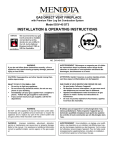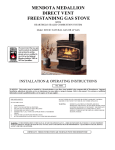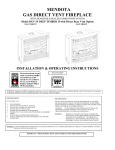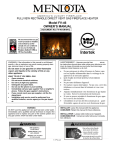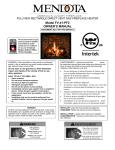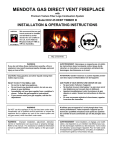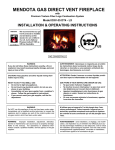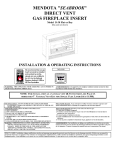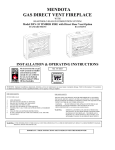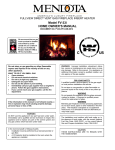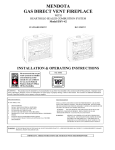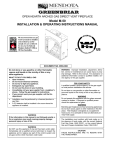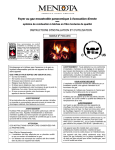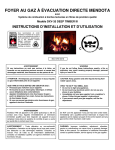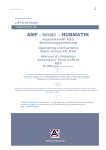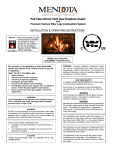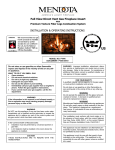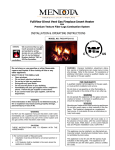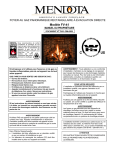Download Mendota DXV-45 Deep Timber III Operating instructions
Transcript
MENDOTA
GAS DIRECT VENT FIREPLACE
Model DXV-45
SHOWN WITH OPTIONAL PRAIRIE DOOR KIT AND OVERLAY
INSTALLATION & OPERATING INSTRUCTIONS
NO. 0406
WARNING: This product must be installed by a licensed plumber or gas fitter when installed in the commonwealth of Massachusetts. Improper installation, adjustment, alteration, service or maintenance can cause injury or property damage. Refer to this manual. For assistance or additional information
consult a qualified installer, service agency or the gas supplier.
FOR YOUR SAFETY:
FOR YOUR SAFETY
IF YOU SMELL GAS:
INSTALLATION AND SERVICE MUST BE PERFORMED BY A QUALIFIED
INSTALLER, SERVICE AGENCY, OR THE GAS SUPPLIER. DO NOT STORE
OR USE GASOLINE OR OTHER FLAMMABLE VAPORS AND LIQUIDS IN THE
VICINITY OF THIS OR ANY OTHER APPLIANCE
WARNING:
DO NOT OPERATE THIS APPLIANCE WITH THE GLASS
REMOVED, CRACKED OF BROKEN. REPLACEMENT OF GLASS
SHOULD BE DONE BY A LICENSED OR QUALIFIED PERSON.
1.
2.
3.
4.
5.
6.
7.
8.
OPEN WINDOWS.
DO NOT TOUCH ELECTRICAL SWITCHES.
DO NOT TRY TO LIGHT ANY APPLIANCE.
EXTINGUISH ANY OPEN FLAME
DO NOT USE THE PHONE IN YOUR BUILDING.
IMMEDIATELY CALL YOUR GAS SUPPLIER FROM A NEIGHBOR'S
PHONE.
FOLLOW THE GAS SUPPLIERS INSTRUCTIONS.
IF YOU CANNOT REACH YOUR GAS SUPPLIER, CALL THE FIRE
DEPARTMENT.
WARNING:
MENDOTA GAS FIREPLACES ARE HEAT PRODUCING
APPLIANCES. DO NOT BURN WOOD, PAPER OR OTHER
MATERIALS IN THE FIREPLACE. THE FIREPLACE IS
DESIGNED AS A SUPPLEMENTAL HEAT SOURCE. IT IS
ADVISABLE TO HAVE AN ALTERNATE HEAT SUPPLY.
WARNING: IF THE INFORMATION IN THIS MANUAL IS NOT FOLLOWED EXACTLY, A FIRE OR EXPLOSION MAY RESULT CAUSING PROPERTY DAMAGE,
PERSONAL INJURY OR LOSS OF LIFE.
IMPORTANT: THESE INSTRUCTIONS ARE TO REMAIN WITH THE HOME OWNER!
TABLE OF CONTENTS
LOCATING THE FIREPLACE AND GENERAL INFORMATION
SPECIFICATIONS & CLEARANCES
INSTALLATION INSTRUCTIONS
GAS SUPPLY REQUIREMENTS
GAS PRESSURE REQUIREMENTS
EXTERIOR VENTING LOCATIONS AND RESTRICTIONS
FLUE VENTING INSTRUCTIONS
FLUE VENTING REQUIREMENTS
FLUE VENTING COMPONENTS
MINIMUM RISE THROUGH-THE-WALL VENTING
ELEVATED THROUGH-THE-WALL VENTING
VERTICAL THROUGH-THE-ROOF VENTING
DESIGNER FRONTS INSTALLATION INFORMATION AND CAUTIONS
GLASS DOOR OPERATION
COAL BED AND LOGS INSTALLATION
INSTALLATION & LIGHTING CHECK OFF LISTS
LIGHTING INSTRUCTIONS
THERMOSTAT OR REMOTE CONTROL OPERATION
BLOWER & BURNER REMOVAL& INSTALLATION-BLOWER WIRING
TROUBLE SHOOTING - MAIN BURNER GAS FLAME ADJUSTMENT
CUSTOMER INFORMATION AND TROUBLE SHOOTING
MAINTENANCE
NATURAL TO LP CONVERSION
REPLACEMENT PARTS
WARRANTY QUALIFICATION AND REGISTRATION FORM
WARRANTY
3
4
5
6
7
8
9
10
11
12
13
14
16
18
19
24
25
27
28
29
30
31
32
34
36
37
SPECIFICATIONS
MENDOTA, MODEL DXV-45
High Fire - Adjustable to - Low Fire
BTUH. (MODEL DXV-45)
NAT. GAS
45,000
7,500
BTUH. (MODEL DXV-45)
L.P. GAS
40,000
5,000
NOTE: LP CONVERSION KIT #HA-42-00072 MUST BE PURCHASED SEPARATELY FOR THE DXV-45 FIREPLACE
TO BURN LPG. SEE PG. 32 FOR INSTALLATION INSTRUCTIONS.
MAIN ORIFICE:
MAIN BURNER #36 NAT. GAS-#53 L.P. GAS – FRONT BURNER #44 NAT. - #3/64 LP
OVERALL EFFICIENCY .................... EXCEEDS D.O.E. EFFICIENCY REQUIREMENTS (A.F.U.E.) FOR DIRECT VENT
WALL HEATERS
CO-AXIAL DIRECT VENT FLUE ...... 5" INNER, 8" OUTER
TOTAL WEIGHT .................................. 205 POUNDS
SAFETY ................................................. AGA CERTIFIED PILOT GENERATOR, MILLIVOLT SYSTEM
ACTIVATED WITH SWITCH, THERMOSTAT OR REMOTE CONTROL.
GAS REQUIREMENTS ........................ SUPPLY PRESSURE:
GAS INLET: 3/8" N.P.T.
NAT. GAS:
7" W.C. (5" W.C. MIN., 11" W.C. MAX.)
L.P. GAS:
11.0" W.C. (11" W.C. MIN., 13" W.C. MAX.)
ELECTRICAL REQUIREMENTS........ 120 VOLT
APPROVED VENT SYSTEMS: AMERIVENT, DURAVENT, SELKIRK METALBESTOS, SECURITY CHIMNEY
Certified under ANSI Z21.88-2002•CSA 2-33-2002 and CAN/CGA 2.17 M91. DXV-45 is also deemed in compliance with
ANSI Z21.50•CSA 2.22 2000“Vented Gas Fireplace Heaters" not for use with solid fuel. Approved for bedroom installations
and mobile homes. UL307B approved for "mobile homes, after first sale of home, not for recreational vehicles." “Gas-fired
appliances for use at high altitudes.”
Gas appliances must be tested and certified by a nationally recognized testing and certification agency to American National Standards Institute - ANSI Gas Appliance Safety Standards. For more information see pg. 36.
The Mendota Gas DXV Fireplace has been tested and certified by Intertek Testing Services 8431 Murphy Drive, Middleton, WI
1
CONGRATULATIONS!
You are the owner of a world class, heat producing, gas, direct vent, sealed combustion fireplace.
This elegant, highly efficient Fireplace will be a constant source of comfort and fascination. It will be the focal point of
beauty and interest in your home.
The Mendota Gas Fireplace is a true heating appliance incorporating the traditional aesthetics of fireplace fire viewing
with the controllability and fuel efficiency of a home gas furnace. Of particular interest is the low fuel consumption and
brilliant fire viewing afforded by the realistic, Deep Timber, wood fire-like combustion system.
Carefully read the following instructions prior to actual installation. Proper Mendota Gas Fireplace installation and operation will give you years of safe trouble free comfort and enjoyment.
If you have any questions regarding installation or operation of your Mendota Fireplace please contact your local dealer.
......CAUTION.....
FOR YOUR SAFETY do not install or operate your Mendota Gas Fireplace without first reading and understanding this
manual. Any installation or operational deviation from this manual voids the Mendota Gas Fireplace Warranty and may
prove hazardous!
Due to high temperatures, the Fireplace should be located out of traffic and away from furniture and draperies. Children
and adults should be alerted to the hazards of high surface temperature and should stay away to avoid burns or clothing
ignition. Young children should be carefully supervised when they are in the same room as the Mendota Gas Fireplace.
Clothing or other flammable material should not be placed on or near the Fireplace.
The Mendota Gas Fireplace is a powerful, efficient heating unit. It has been designed as a major source of supplemental
heat. As with any mechanical appliance there can be component shut downs. It is advisable to have an alternate heat supply.
Installation, repair and any adjustments to logs or burner must be done by a qualified service person. The Fireplace
should be inspected before use and at least annually by a professional service person. More frequent cleaning may be
required due to excessive lint from carpeting, bedding material, carbon build-up, etc. It is imperative that control compartments, burners and circulating air passageways of the appliance be kept clean. The burner and pilot flames and logs
should be visually checked periodically.
DO NOT use this Fireplace if any part has been under water or exposed to moisture corrosion. Immediately call a qualified service technician to inspect the Fireplace and replace any part of the control system and any gas control, which has
been under water. DO NOT use this fireplace if the burner does not light immediately. Turn unit off and call Mendota
approved service person if there is any delay in burner light off.
It is Johnson Gas Appliance Company's policy that no responsibility is assumed by the Company or by any of its employees or representatives for any damages caused by an inoperable, inadequate, or unsafe condition which is the result, either
directly or indirectly, of any improper operation, installation or servicing procedures.
BUILDING PERMIT AND INSTALLATION INSPECTION APPROVAL REQUIREMENTS
All installations of Mendota Fireplaces and Inserts must comply with all the
requirements stated in this Installation and Operating Instructions Manual. The
Dealer and/or installer must also obtain all required Building Permits and
Inspection Approval from the local building inspection department or the local
body having jurisdiction. In order to validate warranty coverage, Mendota may
require facsimile copies of the Building Permit and Inspection Approval forms.
Failure to provide adequate proof that the installation conforms to all local
requirements and the requirements stated in the Installation and Operating
Instructions Manual will void all applicable warranty.
2
LOCATING THE FIREPLACE AND GENERAL INFORMATION
Your Mendota Gas Fireplace has a state-of-the-art co-axial direct vent, sealed combustion system. This advanced, highly
efficient system brings in outside air for combustion, has a separate exhaust vent and efficiently heats and re-circulates
room air. The Mendota system maintains high air quality, maximizes efficiency and assures proper operation.
SAFETY AND STRUCTURAL CONCERNS:
The DXV Fireplace must be installed and serviced by a Mendota approved service person. Any adjustments to burner, pilot, logs or
coal bed must be made by a Mendota approved service person. Pilot flame must be checked with voltmeter. Pilot flame must register
a minimum of 250 on millivolt meter. If pilot goes out always wait five (5) minutes before relighting pilot. Always remove the glass
door when lighting the pilot. The burner must light immediately & the flame must travel promptly and smoothly around "curve" and
light entire burner. The flame must not "lift off" burner. All vent pipe sections must be "twist locked" and leak proof.
The Mendota Direct Vent Fireplace may be placed within inches of adjacent sidewalls. (See FIGURE 1 on pg. 4). The fireplace may
be placed directly on concrete or wood flooring. If the appliance is to be installed on carpeting, vinyl or other combustible material
other than wood flooring, the appliance shall be installed on a metal or wood panel extending the full width and depth of the appliance. Combustible mantels must be installed as per FIGURE 1 on pg. 4. Non-combustible (marble, brick, stone, etc.) mantels or
mantels with steel protector plate on underside maybe installed at any desired height above upper grill.
NEVER BLOCK OFF UPPER OR LOWER GRILLS. ALWAYS USE MENDOTA GRILLS, MENDOTA APPROVED VENT
SYSTEMS AND MENDOTA APPROVED VENT CAPS. SEE PAGEA 8-15 FOR SPECIFIC VENTING INFORMATION.
KEEP ELECTRONIC APPLIANCES AWAY: DUE TO THE HIGH TEMPERATURES IN THE VICINITY OF THIS
FIREPLACE, MENDOTA RECOMMENDS THAT ALL ELECTRONIC APPLIANCES INCLUDING AUDIO/VIDEO
APPLIANCES AND THEIR RECORDING MEDIA (ie. TV, VCR, DVD PLAYER, CD PLAYER, TUNERS, TELEPHONES,
CASSETTE TAPES, VIDEO TAPES, CDs, DVD CDs) BE KEPT WELL AWAY FROM THIS FIREPLACE.
VENTING REQUIREMENTS:
Use only Mendota specified vents and vent caps when installing your fireplace. Closely follow venting locations, directions and requirements (see pages 8-15). Observe the restrictions relating to vent position on exterior of home (see pg. 8).
HEATING PERFORMANCE:
Mendota Gas Built-in Fireplaces are true, high efficiency gas heaters. With its high heat output the Mendota Fireplace will heat a
large area of your home if situated to maximize heat circulation. Air movement options for maximizing heat circulation which can be
considered are through-the-wall grills or floor grills, the continuous operation of central heating furnace blowers, or ceiling fan. The
most efficient method for overall heat distribution is a ceiling fan. The heat output of the Fireplace can be reduced down to 22,500
BTUH by slowly turning the Hi/Lo temperature knob on the gas valve counter clockwise from "Hi" to "Lo". Further reduction of heat
output, down to 7,500 BTUH, can be achieved by turning off the rear burner using the switch provided behind the lower grill. The
blower can also be turned down to reduce heat output.
AESTHETIC CONSIDERATIONS:
Burning or static fireplaces are a major aesthetic focus in any room. Locate your gas fireplace as you would a television set. The
Mendota Hearth Gas Fireplace will be a continuing source of comfort and fascination. Corner installations will afford you the greatest
potential for viewing in many rooms.
HEARTH PROTECTION REQUIREMENTS: A non-combustible hearth protector is required and must extend a minimum of 14"
in front of the fireplace (see Figure 1 on pg. 4 for raised hearths). We suggest installing the Mendota Fireplace 6 to 12 inches above
the floor by utilizing an elevated hearth.
CAUTION: If you intend to install either the Andover Door Front or the Prairie Door Front on this fireplace, make certain that the top
surface of the hearth protector is flush with the bottom surface of the fireplace, no higher. Failure to follow this guideline will prevent
proper mounting and function of these two Fronts. See Page 16 for specific details.
ELECTRICAL REQUIREMENTS:
A blower is standard on your Mendota Direct Vent Fireplace; A 120 volt electrical service must be supplied at the fireplace location at
the time of installation. It must be electrically grounded in accordance with local codes or in their absence with current edition of the
National Electric Code ANSI/NFPA 70. Power supply to blower must be continuous. DO NOT use switch or variable control in
power supplied to fireplace.
The blower on this appliance is equipped with a three-prong plug for protection against shock hazard and should be plugged directly
into the grounded three-prong receptacle provided with the fireplace. Do not cut or remove the grounding prong from the plug.
NOTE: The blower output can be adjusted with the rheostat. There will be delays in blower operation during "heat-up" (approx. ½
hr.) and extended blower operation during "cool-down" (approx. ½ hr.) of unit (see Blower Wiring Diagram pg. 28).
Thermostat wire should be run from desired thermostat location (or "on/off") switch to the fireplace terminals (located behind lower
grill) – see thermostat installation section (pg.27).
3
DXV-45 GAS DIRECT VENT FIREPLACE
SPECIFICATIONS & CLEARANCES
DIRECT VENT SIZE: 5" I.D., 8" O.D.
51 7/16
51 7/16
FIGURE 1: Specifications & Clearances
4
INSTALLATION INSTRUCTIONS
CAUTION: Each installation must conform to all local, state and national codes. Refer to the national fuel gas code and local zoning and code authorities for details on installation requirements. The Mendota Fireplace must be vented to the outside in accordance with the latest edition of the National Fuel Gas Code. In the
absence of local codes, the installation must conform with the most current edition of the National Fuel Gas Code ANSI Z223.1, also known as NFPA 54. NOTE:
The Mendota DXV Fireplace is approved for mobile home and bedroom installations.
CAUTION: The Mendota DXV Fireplace may be installed in a manufactured (mobile) homes after the first sale of the home. Manufactured home (mobile home)
installation must conform with the Manufactured Home Construction and Safety Standard, Title 24 CFR, Part 3280, or, when such a standard is not applicable, the
Standard for Manufactured Home Installations, ANSI A225.1/NFPA 501A, or CSA Z240.4-Gas Equipped Mobile Housing. Consult your local building official.
Note: For mobile home installations unit must be bolted to the floor and properly grounded.
1. After selection of the desired fireplace location (see pg. 3), prepare the rough opening using framing dimensions on
page 4. Prepare opening to allow for co-axial vent (see "Flue Venting Instructions" on pgs. 8 -15).
2. Check to make certain all venting requirements and locations are being followed. (See pg 8 -15).
3. The Fireplace is designed to be installed into rough framing. The drywall will cover the adjustable nailing flanges on
the Fireplace sides. Before sliding the Fireplace into the framed opening, adjust the nailing flanges to accommodate
the thickness of the wall material. NOTE: FRAMING MATERIAL ABOVE FIREPLACE MUST MAINTAIN
CORRECT CLEARANCES TO VENT PIPE.
4. Slide Fireplace into the rough framed opening. When finishing the unit, combustible materials may overlay nailing
flanges and come in contact with the side edges of the black front surface, but may not overlay the 2" black surface.
A 40-1/8” x 4” Top Screw Strip (part #HA-41-00015) is supplied with the fireplace and must be installed on the top
of this fireplace. The Top Screw Strip provides a 4” clearance to combustible materials at the top of the fireplace.
See Page 4 for specific details. Combustible wall covering materials may only be installed down to the top flat
edge of the Top Screw Strip. Noncombustible boards such as “Dura-Rock” or “wonder board” can be installed on
top of the face of the Top Screw Strip and on top of the rest of the black face of the fireplace. Noncombustible material, such as marble or brick, can be installed over the 2" black surface up to the inside edges of black frame only
if some Designer Fronts are to be installed. See Page 16 for specific details and exceptions. Rough framing can
come no closer to unit than the stand-offs.
5. Level the Fireplace and secure into opening by nailing through the nailing flanges on cabinet side panels. Holes are
provided in fireplace floor behind grill to lagscrew fireplace to floor, if required.
NOTE: A removable panel in the enclosure for future visual inspection of the flue connection is recommended
6. Have an electrician install a 120 Volt supply to the junction box on lower left side of the fireplace cabinet. Connect
wires to the duplex outlet. This duplex outlet is removable from outside of cabinet for easy wiring. Make sure the
outlet is properly grounded and that the installation conforms to all local and national wiring codes. See "Blower
Operation" below, Blower Wiring Diagram pg. 28 and "Electrical Requirements" pg. 3.
7. Have gas supplier or qualified plumber install gas supply line to fireplace and connect to gas nipple. Be sure gas
and plumbing instructions (see pgs. 6-7) and all local and national codes are carefully followed. Carefully check
for gas leaks and for proper gas pressure.
IMPORTANT:
Any safety screen, guard, glass, grill, pressure relief cap, etc. removed for servicing a fireplace/room heater must be replaced
prior to operating the fireplace/room heater.
BLOWER OPERATION
The Mendota DXV Fireplace is designed so the blower operates continually when main burner is on. The blower output can be
regulated with the rheostat (included). NOTE: There will be a time delay in blower operation during "heat-up" (approx. 1/2 hour)
and extended blower operation during "cool-down" of unit. (Approx. 1/2 hour).
OPERATION DURING POWER OUTAGES
The fireplace is designed to operate during power outages. The blower will not operate, but natural convection can be improved by
removing the upper Millenia grills, opening the Andover and Prairie Doors and opening the Wellington Screens.
5
GAS SUPPLY REQUIREMENTS
CORRECT GAS PRESSURE AND PROPER GAS SUPPLY LINE SIZING IS IMPERATIVE TO THE SUCCESSFUL PERFORMANCE OF YOUR MENDOTA
GAS FIREPLACE. BE SURE THE GAS SUPPLIER OR PLUMBER CAREFULLY CHECKS FOR CORRECT GAS PRESSURE AND GAS LINE SIZING WHEN
INSTALLING THE FIREPLACE.
IT IS CRITICAL TO CAREFULLY CHECK FOR GAS LEAKS WHEN HOOKING UP THE FIREPLACE -- CHECK WITH SOAP & WATER SOLUTION.
BE SURE TO INSTALL "APPROVED" FLEX GAS LINE WITH BRASS-TO-BRASS FITTINGS TO PREVENT GAS LEAKS AT CONNECTIONS.
GAS SUPPLY PIPING MUST INCLUDE A DRIP LEG TO ELIMINATE THE POSSIBILITY OF CONTAMINANTS ENTERING THE GAS TRAIN.
ADHERE STRICTLY TO LOCAL AND NATIONAL CODES FOR ENTIRE INSTALLATION.
GAS SUPPLY LINE SIZING
Gas supply piping can enter the Fireplace cabinet from either the left or right side.
Install an approved individual shut-off valve in supply line to the fireplace. The appliance and its individual
shut-off valve must be disconnected from the gas supply piping system during any pressure testing of that sytem
at test pressures in excess of 1/2 PSIG (3.5 kPa).
The appliance must be isolated from the gas supply piping system by closing its individual manual shut-off
valve during any pressure testing of the gas supply piping system at test pressures equal to or less than 1/2 PSIG
(3.5 kPa).
The proper gas line diameter must be selected to run from the supply regulator to the Fireplace. Refer to the following table for proper gas pipe diameters. Strictly adhere to the correct pipe sizes.
PIPE LENGTH
(FEET)
SCHEDULE 40 PIPE
INSIDE DIA.
NAT.
TUBING, TYPE L
OUTSIDE DIA.
L.P.
NAT.
L.P.
0-10
1/2" (1.3 cm)
3/8" (1.0 cm)
1/2" (1.3 cm)
3/8" (1.0 cm)
10-40
1/2" (1.3 cm)
1/2" (1.3 cm)
5/8" (1.6 cm)
1/2" (1.3 cm)
40-100
1/2" (1.3 cm)
1/2" (1.3 cm)
3/4" (2.0 cm)
1/2" (1.3 cm)
100-150
3/4" (2.0 cm)
1/2" (1.3 cm)
7/8" (2.3 cm)
5/8" (1.6 cm)
150-200
3/4" (2.0 cm)
1/2" (1.3 cm)
7/8" (2.3 cm)
3/4" (2.0 cm)
NOTE: Some areas allow copper tubing or galvanized pipe - check with local approval agencies and codes NEVER use plastic pipe.
GAS PRESSURE CHECKING REQUIREMENTS
Inlet and manifold gas pressure checking taps are located on gas valve. (See FIGURE 2 pg. 7) A qualified installer should use these fittings for setting the correct gas pressure during initial installation.
NOTE:
DO NOT DAMAGE OR KINK THE FLEX CONNECTOR. CHECK FOR GAS LEAKS
WITH SOAP AND WATER SOLUTION.
NOTE:
3/8" FLEX OR RIGID PIPING MAY BE USED TO CONNECT GAS SUPPLY TO UNIT
DEPENDING ON STATE AND LOCAL CODES.
NOTE:
BE SURE TO INSTALL FLEX GAS HOSE WITH BRASS-TO-BRASS FITTINGS TO
PREVENT LEAKS AT CONNECTION.
6
GAS PRESSURE REQUIREMENTS
A MAJOR CAUSE OF OPERATING PROBLEMS WITH GAS APPLIANCES CAN BE IMPROPER GAS PRESSURE!
Such problems as changes in flame color or configuration, gas pilot or burner outages, intermittent operation, changes in
heat output, excessive burner noise, etc. can be the result of changes in gas pressure or improper gas pressure at the time
of the installation. The most important item to check during the installation and the first thing to check when problems
occur is gas pressure!
Gas supplies normally enter a residence at 1/2 PSI (13" - 15" W.C.) (3. KPA). A regulator is then placed inside the residence which drops this pressure to 7" W.C. (1.8 KPA) (Nat. Gas). This "inches to inches" regulator is of adequate capacity to service the gas appliances (such as dryer, furnace, etc.). If this regulator's capacity is not sufficient to add the Gas
Fireplace, an additional "inches to inches" regulator must be installed for the Fireplace. EXCEPTION: Some codes allow
2 PSI (1.4KPA) supplies to enter the residence, in which case "pounds to inches" regulators are used.
The following table provides information on correct gas pressure requirements. Be sure your gas supplier or plumber
carefully follows this table.
GAS PRESSURE REQUIREMENTS
DESIRED
INLET
PRESSURE
MINIMUM
INLET
PRESSURE
MAXIMUM
INLET
PRESSURE
MANIFOLD
OUTLET
PRESSURE
AIR SHUTTER
POSITION
NATURAL GAS
7.0" W.C.
(1.75 kPa)
5.0" W.C.
(1.12 kPa)
11" W.C.
(2.61 kPa)
3.5" W.C.
(0.87 kPa)
1/8 - 1/4 " OPEN
(7 mm)
L.P. GAS
11.0" W.C.
(2.75 kPa)
11" W.C.
(2.75 kPa)
13.0" W.C.
(3.24 kPa)
10.0" W.C.
(2.5 kPa)
1/2 " OPEN – min.
(14 mm)
TURN GAS VALVE KNOB TO "HIGH" POSITION. GAS PRESSURES MAY VARY PLUS OR MINUS 5%
*AIR SHUTTER POSITION MAY VARY WITH Altitudes ABOVE 5,000 FT.
Manifold pressure must be taken at the outlet ("MANIFOLD") tap and inlet pressure at the "INLET" tap with the
burner operating by a qualified installer (see FIGURE 2: Pressure Test Port).
FIGURE 2: Pressure Test Port
7
EXTERIOR VENT LOCATIONS AND RESTRICTIONS
FIGURE 3: Exterior Vent Locations
All vent measurements given below are from the center of the vent cap.
∨ - Vent Terminal
∧ - Air Supply Inlet
≡ - Area where terminal is not permitted
A=
Clearance above grade, veranda, porch, deck, or balcony (*12 inches (30 cm) minimum)
H=
*Not to be installed above a meter/regulator assembly
within three feet (90 cm) horizontally from the center-line
of the regulator
B=
Clearance to window or door that may be opened
(*12 inches (30 cm) minimum.
I=
Clearance to service regulator vent outlet (*6 feet (1.8m)
minimum)
Clearance to non-mechanical air supply inlet to building or
the combustion air inlet to any other appliance.
(*12 inches (30 cm) minimum.
C=
Clearance to permanently closed window (minimum 12
inches (30 cm) recommended to prevent condensation
on window)
D=
Vertical clearance to ventilated soffit located above the
terminal, from the center-line of the terminal, 18 inches
(46 cm) minimum. 24” to vinyl soffit.
K=
Clearance to a mechanical air supply inlet (*6 feet (1.8 m)
minimum)
E=
Clearance to unventilated soffit (18 inches (46 cm)
minimum). 24” to vinyl soffit.
L=
† Clearance above paved side-walk or a paved driveway
located on public property (*7 feet (2.1 m) minimum)
F=
Clearance to outside corner - six inches (15 cm)
M=
Clearance under veranda, porch, deck, or balcony (*24
inches (60 cm) minimum ‡)
G=
Clearance to inside corner - 24 inches (61 cm). 24” (60
cm) to vinyl surfaces.
J=
† A vent shall not terminate directly above a sidewalk or paved driveway, which is located between two single-family dwellings and serves both dwellings.
‡ Only permitted if veranda, porch, deck, or balcony, is fully open on a minimum of two sides beneath the floor.
* As specified in CGA B1:19 Installation Codes (1991). Note: Local codes or regulations may require different clearances.
8
FLUE VENTING INSTRUCTIONS
The Mendota Fireplace must be vented using DuraVent or Amerivent or Security venting system. All warranties will be voided and serious fire, health or other safety hazards may result from any of the following actions:
Installation by unauthorized personnel; Installation of any damaged component; unauthorized modification of
vent system; installation of any components not manufactured or approved by security chimney Simpson
DuraVent, Amerivent and Mendota; failure to meet all clearance requirements; failure to properly twist-lock all
components.
Consult local building codes before beginning the installation.
WARNING
Always maintain required clearances (air spaces) to combustibles to prevent a fire hazard. Do not fill air spaces
with insulation. Check installation instructions for minimum clearance requirements between the outer walls of
the vent pipe and nearby combustible surfaces. Be sure to check the vent termination clearance requirements
from decks, windows, soffitts, gas regulators, air supply inlets, and public walkways, as specified in these installation instructions and local building codes. SAFETY PRECAUTIONS FOR THE INSTALLER: 1) Wear gloves
and safety glasses for protection; 2) Exercise extreme caution when using ladders or on roof tops; and 3) Be
aware of electrical wiring locations in walls and ceilings.
The gas appliance and vent system must be vented directly to the outside of the building, and never attached to
a chimney serving separate solid fuel or gas burner appliance. Each direct vent gas appliance must have its own
separate vent system. Common vent systems are prohibited.
To assure proper venting performance of the high-performance Mendota Direct Vent Fireplaces and Stoves, it is
critical that the DuraVent GS vent pipe sections are sealed tightly and leak-proof. This means that all pipe sections must be carefully rotated into the fully "twist-locked" position (Dura Vent only).
WE STRONGLY RECOMMEND THAT FIXED LENGTH PIPE SECTIONS BE USED IN PLACE OF
TELESCOPING SECTIONS WHENEVER POSSIBLE
Note: When using Dura-vent DV pipe you must use a silicate stove masonry sealant [Millpak Sealant
#65-06-00909] on all inner pipe joints. On the exterior (air intake) pipe joints, high temperature foil tape
may be used instead of the masonry sealant. Contact your dealer to obtain this sealant material.
DO NOT SEPARATE TELESCOPING SECTIONS. THEY MUST BE USED AS COMPLETE
ASSEMBLIES.
COMPONENT "TWIST-LOCK" CONNECTION PROCEDURE
DuraVent, Amerivent and Security brand pipe and fittings are designed with special
twist-lock connections. Twist-lock procedure is as follows: four (4) indentations,
located on the female ends of pipes and fittings are designed to slide straight in to
the male ends of the adjacent pipes and fittings, by orienting the four pipe identifications so that they match and slide into the four entry slots on the male ends
(FIGURE 4).
Push the pipe sections completely together then twist-lock one section clockwise,
approximately 1/4 turn until the two sections are fully locked. The female locking
lugs will not be visible from the outside on the black pipe or fittings.
FIGURE 4: Twist-Lock Piping
9
FLUE VENTING REQUIREMENTS FOR NG AND LPG
NOTE: IF A 90º ELBOW IS CONNECTED DIRECTLY TO THE FLUE OULET, THE MAXIMUM HORIZONTAL
DISTANCE FROM THE FLUE OUTLET CENTERLINE TO THE OUTSIDE WALL IS 24".
A MAXIMUM OF THREE (3) 90ºELBOWS ARE ALLOWED PER INSTALLATION.
EACH 90º ELBOW USED, AFTER THE FIRST 90O ELBOW, REDUCES THE MAXIMUM HORIZONTAL DISTANCE
BY 3'. EACH 45O ELBOW USED, AFTER THE FIRST 90O ELBOW, REDUCES THE MAXIMUM HORIZONTAL
DISTANCE BY 1-1/2’.
10
5"/ 8"FLUE VENTING COMPONENTS FOR NG AND LPG
ITEM #
1
1
1
1
2
3
4
5
9
10
10
11
12
13
14
15
16
17
PART #
45-01-00222
45-01-00223
45-01-00224
45-01-00225
45-01-00228
45-01-00227
45-01-00229
45-01-00226
45-01-00239
45-01-00236
45-01-00237
45-01-00238
45-01-00230
45-01-00234
45-01-00231
45-01-00235
45-01-00221
AA-11-00458
DESCRIPTION
12" VENT STACK 5" / 8"
24" VENT STACK 5" / 8"
36" VENT STACK 5" / 8"
48" VENT STACK 5" / 8"
90ºGALVANIZED ELBOW 5" / 8"
45º GALVANIZED ELBOW 5" / 8"
ADJUST. WALL THIMBLE 5" / 8"
11 - 14" ADJUSTABLE PIPE 5" / 8"
ATTIC INSULATION SHIELD 12" 5"/8"
ROOF FLASHING (0/12 TO 6/12) 5"/ 8"
ROOF FLASHING (7/12 TO 12/12)5"/8"
STORM COLLAR 5" / 8"
VERTICAL VENT CAP 5" / 8"
SUPPORT BAND 5" / 8"
HORIZONTAL VENT CAP 5" / 8"
FIRESTOP SPACER 5" / 8"
6" VENT STACK GALV. 5" / 8"
HEAT SHIELD (FOR VINYL, WOOD & COMBUSTIBLE SIDING)
Figure 5: Flue Venting Components
Adjustable– telescoping – pipe sections must be sealed using 1000°
MILLPAK SILICATE STOVE MASONRY SEALANT (part #65-06-00909).
11
A-1
MINIMUM RISE THROUGH-THE-WALL VENTING FOR NG AND LPG
WARNING: ALWAYS USE HEAT SHIELD (#AA-11-00458) WHEN EXTERIOR WALL COVERING IS MADE OF VINYL, WOOD OR
OTHER COMBUSTIBLE MATERIALS. HEAT SHIELD (#AA-11-00458) IS INCLUDED WITH THE DXV45 FIREPLACE.
HEAT SHIELD #AA-11-00458
HEAT SHIELD
AA-11-00458
Y
The horizontal distance from flue outlet center to outside wall must not exceed 24" if a 90o elbow is connected
directly to flue outlet. ALWAYS MAINTAIN 1" CLEARANCES FROM VENT PIPE TO COMBUSTIBLES,
2" ABOVE PIPE ON HORIZONTAL RUNS. Use "fixed" pipe sections in place of adjustable pipe sections
wherever possible. If adjustable pipe sections must be used, 1000º Millpak sealant (#65-06-00909) must be
used on the inner pipe joints (Duravent Only). Do not fill air spaces within the required clearance distances (1”
around vertical pipe sections and 2” above horizontal pipes and fittings) with insulation or other material.
IMPORTANT: REFER TO DRAWINGS ON PAGE 10 & 11 WHILE FOLLOWING THESE
INSTRUCTIONS.
1. Position fireplace in desired location. See pg. 8 for guidelines on proper vent cap placement on the exterior
of home. Check to determine if wall studs are in the way when venting system is attached. If this is the
case, you may want to adjust the fireplace location.
2. Measure from the top of the fireplace up minimum 7 1/2" from top of fireplace to centerline of 90º elbow
(See FIGURE 1. pg. 4) and mark wall directly at the center of where the vent pipe will penetrate the wall.
3. Cut and frame a 10-3/4" x 10-3/4" opening in the outside wall. The hole must be positioned so the vent system will run level or have a ¼ " rise AND be perpendicular to the wall. The height of the opening must be
located to meet all local and national building codes and not allow the termination to be easily blocked or
obstructed. If wall being penetrated is non-combustible material, i.e. masonry block, brick, etc., an 8 ½" diameter hole is acceptable. A Wall Thimble (#45-01-00229) must be used when penetrating a combustible
wall.
4. Make sure that all component connections are in their fully twist-locked position and are leak-proof. Make
sure that 1000º Millpak sealant (#65-06-00909) is used on the inner pipe joints of all pipe sections (Dura
Vent only).
*NOTE: DO NOT SEPARATE TELESCOPING SECTIONS. USE AS COMPLETE ASSEMBLIES.
5. The length of the horizontal piece that fits through the wall will be determined by the thickness of the wall.
When installed, the end of the horizontal piece must be flush with the exterior wall of the home. There
MUST be a minimum of 1" air space clearance to combustibles from all vent pieces (2" above horizontal
runs).
6. From the exterior of the home, slide the horizontal vent cap over the end of the horizontal pipe and tightly
secure the cap to the wall with screws. Seal with a high quality caulking.
NOTE: The Horizontal Vent Cap should not be recessed into the wall or siding.
12
A-2
ELEVATED RISE THROUGH-THE-WALL VENTING FOR NG AND LPG
The minimum vertical rise from top of fireplace, is 48 in. when used with the maximum horizontal run of 16 ft.
For other venting configurations within these maximum limits see pg. 10.
NOTE: All horizontal runs of vent pipes must have a ¼" rise for every 1' of run toward the termination. Never
allow the vent to run downward. This will cause high temperatures and the possibility of a fire.
USING OFFSETS AND RETURNS: A single 90º vertical-to-horizontal elbow is already calculated into the
allowable maximum 16' horizontal run. Each additional 90º elbow reduces the maximum horizontal distance
by 3'. A maximum of two 90° or four 45° elbows, in addition to the first 90o elbow, can be used (total equivalent of three (3) 90o elbows in entire vent system. 45º elbows reduce the maximum horizontal distance by 1½ '.
SUPPORT: Horizontal runs of pipe will require one vent support for every 3 ft. of pipe.
CAUTION: Be sure to maintain 1" air space clearances to any combustibles around all pipe sections that are
vertical. Be sure to maintain 1” air space clearances to any combustibles on the sides and below all horizontal
pipe sections and elbows and 2" from the top of all horizontal pipes and fittings.
IMPORTANT: REFER TO DRAWINGS ON PAGE 10 & 11 WHILE FOLLOWING THESE
INSTRUCTIONS.
1. Position fireplace in desired location. See pg. 8 for guidelines on proper vent cap placement on exterior of
home. Check to determine if wall studs are in the way when vent system is attached. If this is the case you
may need to adjust the fireplace location.
2. Locate position where vent pipe will pass through any ceilings and will penetrate the outside wall. Since
vent pipe sections "overlap" we suggest pre-assembling and measuring the total vent pipe run so you can
more accurately locate the point where the vent pipe will penetrate the outside wall. (See FIGURE 3: Exterior Vent Locations, pg.8). Be sure all vent components are properly twist locked and leak-proof. Be sure
1000º silicate sealant (Millpak #65-06-00909) is used in the inner joints of all pipe sections (Dura Vent
only).
*NOTE: DO NOT SEPARATE TELESCOPING SECTIONS USE AS COMPLETE ASSEMBLIES.
3. Cut and frame a 10-3/4" x 10-3/4" opening in the outside wall and in any ceiling openings. The outside wall
hole must be positioned so the vent system will have a ¼ " rise per foot of run AND be perpendicular to the
wall. The height of the opening must be located to meet all local and national building codes and not allow
the termination to be easily blocked or obstructed. A ceiling fire stop spacer is required at any floor (ceiling) opening.
4. Connect a 90° elbow to the fireplace adapter on top of fireplace vent outlet.
5. Always use a Wall Thimble (#45-01-00229) when penetrating a combustible wall.
6. The horizontal pipe must end flush with the exterior wall of the home. Horizontal pipe will require a proper
support (part #45-01-00234) every 3 ft. of vent pipe. THERE MUST BE A MINIMUM OF 1"
CLEARANCE TO COMBUSTIBLES FROM ALL VENT PIECES (2" above horizontal runs). From the
exterior of the home, slide the horizontal vent cap over the end of the horizontal pipe and tightly secure the
vent cap to the wall with screws. Seal with high quality caulking.
NOTE: Venting terminal should not be recessed into the wall or siding.
13
B-1
VERTICAL THROUGH-THE-ROOF VENTING FOR NG AND LPG
The maximum vertical run of vent pipe is 36 ft. from the top of the fireplace. The fireplace will support a run of
a maximum of 36 ft. Maintain 1" air space clearances on all sides of vents (2" above horizontal vents).
IMPORTANT: REFER TO DRAWING ON PAGE 10 & 11 WHILE FOLLOWING THESE INSTRUCTIONS.
1. Place the fireplace in its desired location. Drop a plumb bob from the ceiling to the center position of the fireplace
flue exit. Mark the location where the vent will penetrate the ceiling. Drill a small hole at this point. Next, drop a
plumb bob from the roof to the hole previously drilled in the ceiling. Mark and drill the spot where the vent will
penetrate the roof. Determine if ceiling joists, roof rafters or other framing will obstruct the venting system. You
may need to relocate the fireplace or need to offset, to avoid cutting load bearing members.
2. Cut and frame a 10-3/4" x 10-3/4" opening in the ceiling centered on the hole drilled in No. 1.
3. To determine the length of the vent pipe required, measure the distance from the fireplace flue outlet to the ceiling,
the ceiling thickness, the vertical rise in the attic or second story and allow sufficient vent height above roofline. For
two story installations, fire stops are required at each floor level. If an offset is needed in the attic, additional pipe and
elbows will be required.
4. Assemble the desired lengths of vent pipe and elbows to reach from the fireplace flue outlet. Ensure that all pipe and
elbow connections are in there fully twist-lock position and are leak-proof. Maintain 1" airspace clearances to combustibles (2" above horizontal runs). Be sure 1000º silicate sealant (Millpak #65-06-00909) is used on the inner pipe
joints of all pipe sections (Duravent Only).
5. Cut a 12" x 12" opening in the roof, centered in the small drilled hole placed in the roof in No. 1. The opening
should be a sufficient size to meet all clearance requirements. Continue to assemble lengths of pipe and elbows necessary to reach up through the roofline. Galvanized pipe and elbows may be utilized in the attic, as well as above the
roofline. The galvanized finish is desirable above the roofline due to its higher corrosive resistance.
a)
If an offset is necessary, it is important to support the vent pipe every 3 ft. to avoid excessive stress on the elbows
and possible separation. Wall straps (#45-01-00231) are available for this purpose.
b) Whenever possible, use 45º elbows instead of 90º elbows. The 45º elbow offers less restriction to the flow of
flue gases and intake air. If a 90º elbow is necessary there must be a minimum of a one-foot pipe section rise after
the 90º elbow to the vent cap or to the next offset. A maximum of three (3) 90ºelbows are allowed per installation.
c) Each 90º elbow, after the first 90o elbow, reduces the maximum horizontal distance by 3'. Each 45o elbow, after
the first equivalent 90o elbow, reduces the maximum horizontal distance by 1-1/2’.
6. Slip the flashing over the pipe sections protruding through the roof. Secure the base of the flashing to the roof with
roofing nails and seal flashing to roof. Ensure the roofing material overlaps the top edge of the flashing. Verify you
have at least the minimum clearance to combustibles at the roofline.
7. Continue to add pipe sections until the pipe and the vent cap meet the minimum building code requirements, as outlined in No. 8 on the following page.
a)
For multi-story vertical installation, a ceiling fire stop is required at the second floor and any subsequent floors. The
opening should be framed to 12" x 12" inside dimensions as described in step No. 5.
b) Any occupied areas above the first floor, including closets and storage spaces, which the vertical vent passes through,
must be enclosed. The enclosure may be framed and sheet rocked with standard construction materials, however, be sure
to maintain minimum allowable clearances between the outside of the vent pipe and the combustible surfaces of the enclosure.
14
8. Height "*H" of top of vent cap can be determined as follows:
ROOF PITCH
FLAT to 6/12
7/12 to 9/12
10/12 to 12/12
13/12 to 16/12
17/12 to 21/12
"H" DIMENSION
FEET
METERS
2
.6
2
.6
4
1.2
6
1.8
8
2.4
1"
9. Complete installation with storm collar and vent cap.
15
MENDOTA DESIGNER FRONTS INSTALLATION INFORMATION
The following Designer Fronts are available for the DXV-45 Fireplace:
1.
2.
Andover Arched Door Kit with Firescreen with optional Overlays as listed below:
a.
Black Andover Overlay
b.
Pewter Andover Overlay
c.
Antique Copper Andover Overlay
d.
Gold Andover Overlay
Prairie Rectangular Door Kit with Firescreen with optional Overlays as listed below:
a.
Black Prairie Overlay
b.
Pewter Prairie Overlay
c.
Antique Copper Prairie Overlay
d.
Gold Prairie Overlay
3.
Black or Gold Victoria Filigree
4.
Black or Gold Tuscany Filigree
5.
Millenia Flat Grills in four optional color schemes as listed below:
a.
Black Millenia Flat Grills
b.
Full Brass Millenia Flat Grills
c.
Classic Black and Brass Millenia Flat Grills
d.
Classic Black and Bright Silver Millenia Flat Grills
Information specific to the installation of the Andover and Prairie Fronts
The Andover Door and Prairie Door Fronts are designed to be “Full-Face” trim kits. These two Fronts cover an area equivalent to that
shown in the diagram below. Any material that protrudes into this area on the sides, top or bottom edges can only be flush with the
front surface of the fireplace faceplate.
If planning to install either the Andover
Door or the Prairie Door Front, DO NOT
COVER THE FACEPLATE OF THE
FIREPLACE WITH ANY MATERIALS.
Furthermore, any drywall or wall covering
material that is adjacent to the sides, top or
bottom of the Fireplace’s faceplate may not
protrude out past the front surface of the
Fireplace Faceplate’s front surface.
The Andover and Prairie Doors
Mounting Faceplate (required for
installation of the Andover and
prairie Doors) may be covered over
with noncombustible facing materials.
To install Tile, Marble, Slate, Stone, Rocks
or other noncombustible to enhance the arch
shape of the Andover Doors or the
Rectangular shape of the Prairie Doors, do
so only after the Andover or Prairie Door
Kits have been installed on the DXV-45
Fireplace.
16
Hearth Protection Pad Installation Information when
planning to Install the Andover or Prairie Fronts
Any hearth protection pad installed in front of the DXV-45 Fireplace
must be designed, built and installed so that the hearth protection pad’s
top surface is flush with the bottom-most surface of the DXV45
Fireplace. See the diagram to the right.
HEARTH PAD
SURFACE
HEARTH PAD SURFACE MUST BE
FLUSH WITH FIREPLACE BOTTOM
Information specific to the installation of Millenia Flat Grills, Victoria Filigrees and Tuscany Filigrees
The Millenia Flat Grills, Victoria Filigree and Tuscany Filigree
are designed to be “inside-fit” trim kits. All of these trim kits fit
within the inner perimeter of the Fireplace’s Faceplate and
remain flush within the Faceplate’s front surface, see Figure
below. This fitting method allows flexibility in covering the
black visible surface of the Faceplate with non-combustible
materials such as Tile, Marble, Slate, Stone and Brick; as long as
enough room is allowed for the removal of these Mendota
Designer Fronts and the glass door for servicing,
WARNING: COMBUSTIBLE MATERIALS MUST
NOT COVER THE FRONT SURFACE OF THE
FIREPLACE’S FACEPLATE.
17
DXV DOOR OPERATION
TO REMOVE DOOR
1. Place both thumbs on lower doorframe directly above Spring Loaded Door Holding Bar.
2. Reach fingers under Bar and pull Bar straight out from Fireplace front.
3. Pull Bar down and move bar inward until bar clears doorframe - then release.
4. Repeat procedure for opposite Holding Bar.
5. Carefully lift door straight up until doorframe "clears" the 3 Door Holding Tabs on top of firebox.
6. Pull door directly out from firebox front
TO REPLACE DOOR
1. Center door in firebox opening. Move door inward until the 3 slots on doorframe are directly above
the 3 Door Holding Tabs on firebox top.
2.
Lower door so the 3 Tabs on firebox top fit through the 3 slots on the doorframe. (i.e. "Hang" door on the 3 Tabs)
3. "Swing in" the lower edge of door until it touches lower firebox front.
4. Pull Holding Bar down and outward (away from Fireplace) until it clears doorframe.
5. Raise Bar until it fits securely in Bar Holding Brackets on doorframe.
6. Repeat procedure for opposite Holding Bar.
CAUTION: Holding Bars MUST be "level" and securely in place on Bar Holding Brackets holding glass door
TIGHTLY against firebox front. The spring-loaded door is a pressure relief safety system and
must be positioned as shown.
WARNING: DO NOT OPERATE THIS APPLIANCE WITH THE GLASS REMOVED, CRACKED OR BROKEN.
REPLACEMENT OF GLASS SHOULD BE DONE BY A LICENSED OR QUALIFIED SERVICE PERSON.
18
COAL BED AND LOGS INSTALLATION
With door removed, proceed as follows:
Carefully unpack the shipping boxes containing the coal bed sections and logs and remove them gently from the
foam packing.
Note: Each coal bed and log is ”lettered” on its underside.
1.
Locate the 3 bags of embers and coals:
LARGE CHUNK COALS - SMALL COALS
- GLOWING EMBERS
2.
Place Coal Bed “A” between front burner and middle burner – to right of pilot. Front Edge of Coal Bed
“A” should sit below the Front Burner Tube. Lift Front Burner Tube Up and Slide Coal Bed under Burner
Tube.
3.
Fill area between fireplace opening and front burner with GLOWING EMBERS. The embers should be
piled up to the top of the front burner.
19
4.
Place right rear log “B” behind back burner as shown. Guide log pins into holes into air box.
5.
Place left rear log “C” behind back burner as shown. Guide log pins into holes into air box.
6.
Place charred log “D” as shown – Between rear burner “U-tube” runners Place log pins into air box holes.
20
7.
Place left front log “E” as shown. Front lower end against left grate upright, and right upper end over pin
in charred log “D”.
8.
Place right log “F” as shown – Front lower end against right grate upright, and right upper end over pin in
charred log “D”.
9.
Carefully place large chunk coals on coal bed “A” - between front and middle burner - in a loose, checkerboard arrangement. Make sure that the coals are not packed too tightly and are only one layer deep.
KEEP PASSAGES CLEAR AROUND EACH COAL AS MUCH AS POSSIBLE. This assures flame
travel around each coal, and a bright glow.
21
10.
Place center forked log “G”as shown. Place front end against grate upright (second from right) and left
rear branch over center shoulder on charred log “D”.
11. Place small log “H” with smooth branch under left log “E”. This log may be placed in front of pilot, BUT
DO NOT REST AGAINST PILOT.
12.
Place small log “I” between logs “E & “G” as shown. There is not one correct location for this log – it may
be placed as desired. The location shown assures the best coal bed glow.
22
13.
With glass removed, light pilot, and check for smooth ignition. Reinstall door, and check again for
smooth ignition. If any delay occurs, make sure that no coals or embers are blocking pilot from front or
rear burner holes.
COMPLETED LOGS AND COAL BED ASSEMBLY EVALUATION
See the picture, shown below. This picture shows the recommended log positions. Slight variations in the
position of each log is allowed. However, if any log position is significantly out of position in comparison
to the diagram below and if any flames are floating off the burner surface after 10 minutes of starting the
fireplace, turn off the fireplace and contact your installer or fireplace dealer. Have the Installer/Dealer
adjust the log positions and also conduct a thorough evaluation of the venting configuration to make certain that the venting configuration conforms to Mendota’s venting requirements, listed in this Installation
and Operations Manual.
23
The following Check Off Lists must be completed prior to final operation of the Fireplace, or
manufacturer's warranty and liabilities will be voided:
INSTALLATION CHECK OFF LIST
Co-axial vent rigid pipe, wall vent cap or roof vent cap must be installed by a
Mendota approved person in accordance with instructions. All joints must be secured, "twist-locked" and leak-proof. 1000º silicate sealant (Millpak #65-0600909) must be used on the inner pipe joints of all pipe sections (Dura Vent
only).
Horizontal or vertical vent cap must be installed "right-side-up" and tightly
sealed to structure per instructions. Vent Caps must be Mendota approved.
Proper exterior and interior clearances for vent systems and locations for wall
vent cap/roof vent cap must be maintained (See pgs. 8-16.)
Carefully check for correct gas pressure, proper size gas lines (see pgs. 6 & 7) and
for gas leaks.
120V electrical service and gas supply must be installed in accordance with instructions and local and national codes.
LIGHTING CHECK OFF LIST
All items on "Installation Check Off List" (see above) must be completed.
Connect thermostat to terminal panel next to gas valve per instructions on pg. 27.
Perform Leak Test on ALL gas fittings on gas train using soap-water solution or
a calibrated combustible gas detector.
System millivolt readings (see pg. 31) must be taken by a qualified installer.
CAUTION: Pilot flame must register a minimum of 250 millivolts.
Check air shutter opening - 1/8" to 1/4" Nat. gas or 1/2" LP gas for Rear Burner.
1/8” Nat. gas or ¼” LP gas for Front Burner
Carefully follow all Lighting and Log Installation Instructions.
Make certain that burner lights immediately and flame runs promptly around
"curve" in burner and lights entire burner. DO NOT proceed with operation
unless burner cycles "on/off" without delays.
Make certain that the flame is "stable" and does not "lift" off burner. If flame
lifts off burner turn unit off and check that vent pipes are twist-locked and leak
proof and vent cap is "right side up".
DO NOT proceed with operation if flame is "lifting off" burner.
Make certain glass door is in properly closed position and "centered" in firebox
opening (see pg. 16).
24
LIGHTING INSTRUCTIONS
IMPORTANT: Be sure all items on "INSTALLATION CHECK OFF LIST" (pg. 24) have been completed!
CAUTION: If the pilot goes out, be sure to wait a minimum of five minutes before relighting - be sure to always remove the
glass before relighting the pilot.
1. Remove glass door (see pg. 18) - ALWAYS LIGHT PILOT WITH GLASS REMOVED!
2. Make sure any gas supply shut-off cocks are open and Thermostat is
"OFF".
3. Push in Gas Cock Dial Slightly and turn clockwise to "OFF". NOTE:
Dial cannot be turned from "PILOT" to "OFF" unless dial is pushed
slightly. DO NOT FORCE!
5. Wait five (5) minutes to allow gas which may have
accumulated in main burner compartment to escape. If you smell gas
STOP.
5. Turn Gas Cock Dial Counterclockwise to "PILOT" position (see Figure 5).
6. Depress Gas Cock Dial and push in red Piezo igniter button. Once pilot ignites,
continue depressing dial for about ½ minute. If pilot does not remain ignited, repeat FIGURE 5: Gas Valve
operation allowing a longer period before releasing Gas Cock Dial.
IMPORTANT: After pilot is lit, system millivolt readings and gas pressure should be taken by qualified installer.
Pilot flame must register a minimum of 250 millivolts (See pg.28)
7. Push Rear Burner ON/OFF switch to “on”. This switch is located behind lower grill on left side. See below.
8. After pilot is lit and before installing logs, turn Gas Dial to "ON" and "cycle" the burner on/off to make certain it
ignites promptly and that the flame runs smoothly around burner curve and promptly lights entire burner.
9. With pilot operating, install log module and coals (see pg. 20). With logs/coals in place, "cycle" the burner again to
make sure of prompt ignition of burner and that the flame runs smoothly around entire burner. NOTE: Logs will
produce a strong, acrid odor on initial contact with flames.
10. Reinstall glass front by "hanging" slots on upper edge of door over tabs on upper edge of firebox opening.
Then "swing in" lower edge of door. Carefully pull out the two (2) Spring Loaded Door Holding Bars located under
the doorframe. Raise Bars and fit Bars firmly into Bar Holding Brackets on door frame (see instructions pg. 18).
11. NOTE: Be sure doorframe is "centered" in firebox opening. To "center": Release Door Holding Bars, with door
"hanging" in upper slots "slide" door frame (within the slots) to center of firebox. Replace Door Holding Bars.
12. Turn Gas Dial counterclockwise to "ON" then set Thermostat or push Remote Control to turn on burner.
13. Main burner should now light IMMEDIATELY and flame should not "lift" off burner. If there is any delay in ignition or if flame is "lifting off" burner, turn off burner and carefully check for proper installation of logs/coals, vent
system and proper pilot flame impingement on burner and thermopile. Logs or coals must not block pilot flame or
main burner flame. Vent system must be leak proof.
DO NOT PROCEED WITH OPERATION UNLESS BURNER "CYCLES" ON/OFF WITHOUT DELAYS!
25
14. To reduce heat output, turn Hi/Lo Knob counterclockwise to desired temperature (see FIGURE 5: Gas Valve).
Heat output can be reduced to 23,000 BTUH using the Hi-Lo Control. NEVER "over fire" by increasing BTUH
above nameplate specifications. NEVER turn down (reduce) pilot flame below the minimum 250 millivolts.
15. To reduce the flame and heat down to 6500 BTUH., use the rocker switch (see step 7) to turn off rear burner.
NOTE: The rear burner is controlled by a 9 Volt DC solenoid valve. One 9 Volt battery (located behind the Battery Compartment cover) provides power for this unique feature. Replace with a new high quality 9 volt battery
annually.
16. Open windows for first two hours of operation.
NOTICE: Initial heater start-up will cause some NON TOXIC "off gassing" of adhesives, gasket binders, paint and other materials. Most
nuisance odors will be eliminated after the first two hours of operation; however, slight amounts may be present during first 24 hours of
initial operation. To eliminate all nuisance odors, continuously operate this fireplace on the HIGH setting for 8 to 12
hours.
SHUT DOWN PROCEDURE:
1. Turn Remote Control or Thermostat to "OFF". Pilot will remain lit for return to normal service.
2. For complete shutdown turn Gas Cock Dial (see FIGURE 5: Gas Valve) to "OFF".
WARNING: Label all wires prior to disconnection when servicing controls. Wiring errors can cause
improper and dangerous operation. Verify proper operation after servicing.
4.
26
THERMOSTAT OR REMOTE CONTROL OPERATION
The Fireplace comes with a wall thermostat. The thermostat should be placed in the same room as the fireplace,
approx. 4-5 ft. off the floor (out of reach of children). Do Not place thermostat near the fireplace.
CAUTION: BURNER SHOULD LIGHT IMMEDIATELY AFTER TURNING THERMOSTAT "ON". IF BURNER DOES NOT COME
ON IMMEDIATELY TURN THE THERMOSTAT OFF AND WAIT 60 SECONDS BEFORE TURNING ON AGAIN. IF BURNER DOES
NOT COME ON IMMEDIATELY AFTER SECOND TRY RECHECK COMPLETE INSTALLATION OF LOGS, PILOT, VENT
SYSTEM, ETC. TO INSURE PROPER PILOT FLAME IMPINGEMENT ON THE THERMOPILE, LOG AND COALS POSITIONING
AND PROMPT BURNER IGNITION. DO NOT OPERATE FIREPLACE IF BURNER DOES NOT LIGHT IMMEDIATELY.
NEVER TURN BURNER ON & OFF "QUICKLY" - ALWAYS WAIT 60 SECONDS!
When using remote control, be sure to hold in button firmly until unit lights. DO NOT push button and release quickly
before burner lights. Burner should light IMMEDIATELY and then button can be released. If unit does not light immediately release button, wait 60 seconds and repeat lighting procedure. If burner does not come on immediately after second try, recheck complete installation. If necessary, contact your Mendota dealer.
NOTE: If thermostat is located over 25 ft. from fireplace the pilot flame may need to be increased up to 525 millivolts.
Use two-wire, copper lead wire per chart below and install as follows:
NOTE: Thermostat Must Be 250-750 Millivolt Rated
RECOMMENDED MAXIMUM
LEAD LENGTH (TWO-WIRE)
WHEN USING WALL THERMOSTAT
(CP-2 SYSTEM)
WIRE SIZE
MAX. LENGTH
14 GA.
100 FT.
16 GA.
64 FT.
18 GA.
40 FT.
20 GA.
25 FT.
22 GA.
18 FT.
Figure 6: Thermostat Wiring
NOTE: Thermostat must be 250-750 millivolt rated.
CAUTION: THIS CONTROL IS A MILLIVOLT SYSTEM. NO ADDITIONAL POWER SUPPLY CAN OR SHOULD BE USED.
27
MENDOTA BLOWER & BURNER REMOVAL & INSTALLATION
BURNER
AIRBOX
REMOVABLE
BURNER PAN/
VALVE ASSEMBLY
BLOWER
ASSEMBLY
NOTE: THE BURNER AND OTHER PARTS SHOWN ABOVE ARE FOR REPRESENTATION PURPOSES ONLY AND
MAY NOT EXACTLY DEPICT WHAT IS INCLUDED IN YOUR FIREPLACE.
BLOWER OPERATION
The Mendota DXV Fireplace is designed so the blower operates at all times the fireplace is operating. The blower output can be
regulated with the rheostat (included), but it must be "on" at all times the burner is "on". NOTE: There will be a time delay in
blower operation during "heat-up" (approx. ½ hour) and extended blower operation during "cool-down" of unit. (Approx. ½ hour)
NOTE: Power supply to blower must be continuous. DO NOT use switch or variable control in power supplied to fireplace.
OPERATION DURING POWER OUTAGE: As the blower will be inoperable during power outages, it is required that any
upper screen grills, louvers, Filigree fascia or screened doors be removed or opened to provide adequate convective air flow.
BLOWER WIRING
5. DIAGRAM
28
TROUBLESHOOTING MENDOTA GAS DXV FIREPLACE
SYMPTOM
PROBABLE CAUSES
CORRECTIVE ACTION
1. Thin black coating (soot)
forms on viewing glass.
A. Incorrect gas pressure
Have gas supplier check for correct gas pressure (7" W.C.
Nat. Gas; 11" W.C. LP Gas).
If sooting continues open-air shutter on burner (see "Gas
Flame Adjustment" below).
If sooting still continues, shut off unit and call Mendota
service person.
NOTE: To clean glass - remove glass and wipe glass with
cloth or paper towel.
B. Not enough combustion air
2. Humming or whistling
coming from Fireplace.
A. Normal operating noise. (See
"Quiet Operation" pg. 25)
Some noise is normal. It is caused by the gas supply flowing through the gas orifice. It is expected from any gas
fireplace. The noise can be reduced by turning the Hi/Lo
Knob on the control. Turning down the flame will reduce
the heat output of the unit.
3. A change in flame appearance or burner operation.
A. A change in gas pressure.
Have your gas supplier check for correct gas 7" W.C. Nat.
Gas; 11" W.C. LP Gas). If flame still needs adjustment see
"Flame Adjustment" below.
Clean out carbon, spider webs, lint, etc. from shutter area.
Logs and burner.
NEVER BLOCK AIR INTAKE OR OUTLET VENTS.
B. Carbon dirt or lint.
FIGURE 7: Air Shutter
DIAGRAM IS FOR REPRESENTATION PURPOSES ONLY AND MAY NOT DEPICT EXACT PART SHAPES.
MAIN BURNER GAS FLAME ADJUSTMENT
During initial installation the burner should be removed by qualified person and the air shutter opening checked to be certain that the shutter is set correctly at 1/8" to 1/4" open for Natural gas and 1/2" minimum open for L.P. gas.
NOTE: For altitudes above 5,000 ft., some variations may be required.
Be sure burner and logs are properly installed (see pg. 18). After burner has been properly installed and operated for two
to three hours, small additional adjustments to the air shutter may be necessary for final flame appearance. These small
shutter adjustments can be made by the following procedure:
NOTE: Very small changes in shutter settings make major changes in flame appearance.
1. Air shutter knob is located behind the lower grill.
2. If flame is too "blue" slowly push air shutter control knob in small 1/16" increments until flame turns desired realistic
"orange."
3. If flame is too "orange" or is causing sooting on viewing glass or on logs, pull air shutter control knob outward in
1/16" increments until sooting stops. IF SOOTING DOES NOT STOP, TURN OFF UNIT AND CALL YOUR
MENDOTA SERVICE PERSON.
4. The front coal bed burner is pre-set at 1/8" open. Normally, no adjustment is required. For LPG applications, a
slightly larger (greater than 1/8” opening in the front burner air shutter may be required if soot deposits on front logs
or on coal chunks).
IMPORTANT: Try each new shutter setting approx. ½ hour before making additional changes. NOTE: Changes in
front burner flame can be made by re-arranging the coals. (See pg.22)
CAUTION: Any changes in pilot flame must be made by qualified person and checked with voltmeter.
29
CUSTOMER INFORMATION AND TROUBLE-SHOOTING
MAXIMUM ALLOWABLE SURFACE TEMPERATURES
Mendota Fireplaces comply with UL Standards for maximum surface temperatures on exposed combustible surfaces adjacent to the unit. The Maximum allowable surface temperature is 117° F. over ambient (room) temperature. Thus, if a room is 70° – 80° the exposed combustible surfaces immediately surrounding the Fireplace
can have a surface temperature as high as 187° F. – 197° F. (too hot to touch). The continuous blower operation automatically keeps temperatures within these safety limits. During Power Outages, remove upper grills on
Millenia Fronts, open doors on Andover and Prairie Fronts and remove upper grills, remove Victoria and Tuscany Upper Face. This will increase convection air flow and prevent overheating.
OVER FIRING OF BURNER
NEVER "over fire" units by adjusting gas pressure or drilling out the orifice to increase BTUH above name-
plate specifications. Over firing can cause permanent damage to firebox and deterioration of parts and void
warranty.
MAINTAINING CORRECT PILOT FLAME - PILOT OUTAGE & RELIGHTING
The pilot flame must be checked with millivolt meter and must always be a minimum of 250 millivolts.
Never lower (reduce) pilot flame below this minimum 250-millivolt setting. (See pg.25.)
If pilot goes out, be sure and wait a minimum of 5 minutes before re-lighting. Always remove glass door before
lighting pilot.
CLEANING VIEWING GLASS
CAUTION: Do Not use oven cleaner to clean glass. The viewing glass should be cleaned periodically. Exterior glass may be cleaned with cleaner as desired. Interior glass - use soap and water, Kel Kem Glass Cleaner
or equivalent.
NOTE: Additives that are put in gas (both natural and propane) to make it smell, can be harmful to glass and
can leave a white film deposit on the glass. This deposit can be removed with cleaners such as KEL KEM “Polish Plus” or comparable product (See your dealer).
In some cases (especially propane) additives can cause “crazing” or etching on the glass. Although this is not
normal, it is not covered under the warranty. The solution may be to change propane suppliers.
SOOTING
Sooting is caused by improper installation or operation. At the first sign of "sooting" (usually a think black film
on the Fireplace viewing glass or on the outside of the home around the vent cap) the unit must be immediately
turned off and the local Mendota dealer promptly informed. Mendota products are designed and tested to operate without producing any "sooting" when installed and operated correctly. Mendota dealers will correct "sooting" problems, but Mendota and their dealers are not responsible for damage caused by excessive sooting that
has not been immediately brought to their attention.
OPERATION DURING POWER FAILURE
The fireplace is designed to operate during power outages. Hot air convection may be improved by removing
upper grill. During a power outage, Hot air convection must be improved by removing upper grill of the Millennia Fronts, opening the doors on the Andover and Prairie Fronts and opening the screen on the Wellington
Front. Remove any inner grills that may cause air flow restriction. Replace these parts for operation after the
unit has cooled completely and power is restored.
30
MAINTENANCE
1. ANNUAL MAINTENANCE OF MENDOTA UNITS IS REQUIRED. The following procedures must be performed each year by a Mendota approved service person. NOTE: Any adjustments to burner, pilot or logs must be
done by a qualified Mendota service person.
A. Clean all lint and dust built-up around the control. Inspect the condition of any wiring under the burner for melting or damage.
B. Remove logs & coals and clean away any foreign matter (lint, carbon, etc.) on the burner and logs. Be sure the
burner ports are "open". Clean the pilot and under side of the logs for any carbon deposits. NOTE: Logs should
be visually checked for carbon "build-up". If carbon deposits are visible on logs, unit should be turned off and
Mendota service person contacted. Be sure logs are re-installed per instructions on page 19.
C. Make sure hot air outlet grills are free from lint and other obstructions. Never block or obstruct grill openings.
Check condition of gaskets, gaskets must be tight, replace if necessary.
D. Check that chimney flue and outlet are open and free of blockage.
E. Before re-installing glass, have qualified service person check the operation of the pilot with millivolt meter and
cycle the burner per LIGHTING INSTRUCTIONS (see pg. 25). Pilot must read a minimum of 250 millivolts.
Be sure all items in LIGHTING and INSTALLATION "check off " lists are completed (see pg. 24).
F. Before re-installing glass, have qualified service person check for door gasket condition and proper seal. If gasket is deteriorated or does not seal properly, replace door gasket.
2. COMBUSTION SYSTEM MILLIVOLT READING:
Millivolt readings must be taken by a qualified installer at the time of installation and after any interruption in burner
operation. These readings will establish proper thermopile millivolt generation and assure trouble-free burner operation. Readings must be taken with: a.) Pilot ONLY operating.
b.) Main Burner operating.
A. PILOT ONLY OPERATING - Thermostat "OFF" - Minimum Millivolts 250
Using a Millivolt Meter, a millivolt reading should be taken by attaching Meter leads to terminals #1 and #2 on
the main gas valve. The Meter must read a minimum of 250 millivolts with the Pilot Light operating, Thermostat turned "OFF" and Main Burner "OFF". To increase or decrease millivolts, (and pilot flame) adjust pilot
screw on control (see Figure 8).
B. MAIN BURNER OPERATING - Thermostat "ON" - Minimum Millivolts 100
Using a Millivolt Meter a millivolt reading should be taken by attaching Meter leads to terminals #2 and #3 on the
millivolt panel on the main gas valve. The Meter must read a minimum of 100 millivolts with the Gas Cock Dial
turned “ON”, Thermostat "ON" and Main Burner operating. To increase or decrease millivolts (and pilot flame)
adjust pilot screw on control (see Figure 8: Millivolt Readings).
CHECK
TEST
TO TEST
CONNECT
METER
LEADS TO
TERMINALS
THERMOSTAT
CONTACTS
METER
READING
SHOULD BE
A
COMPLETE
SYSTEM
2&3
CLOSED
100MV OR
MORE
B
THERMOPILE
OUTPUT
1&2
OPEN
GREATER
THAN
325 MV
C
SYSTEM
RESISTANCE
1&3
CLOSED
2.75 OHMs
MAX
D
AUTO/
PILOT
DROPOUT
1&2
OPEN
BETWEEN
120-30 MV
Figure 8: Millivolt Readings
3. THE VIEWING GLASS SHOULD BE CLEANED
PERIODICALLY. Exterior glass may be cleaned with cleaner as desired. Interior glass - use KEL KEM "Polish
Plus" or comparable product. Do Not use oven cleaner or abrasive cleaners to clean glass. DO NOT CLEAN WHEN
GLASS IS HOT.
4. PERIODIC VISUAL CHECK OF BURNER AND PILOT FLAMES IS REQUIRED.
31
NATURAL TO LP GAS CONVERSION
HA-42-00072
This conversion must be made by a qualified service technician.
A Natural Gas to LPG conversion kit #HA-42-00072 must be purchased separately for the DXV45 Fireplace to
burn LPG.
LP Conversion Kit #HA-42-00072 contains the following parts: One LP Pressure Regulator, One LP Pilot Orifice Thimble, One Cap Orifice drill #53 (for rear burner) and One Cap Orifice drill #3/64 (for front burner).
Specifically, identify the Rear and Front Burner Cap Orifices. Use proper sized drill bits’ shaft ends to verify
orifice sizes.
WARNING: IT IS OF THE UTMOST IMPORTANCE THAT THE CORRECT BURNER ORIFICE BE
INSTALLED FOR BOTH THE REAR AND FRONT BURNERS.
1. Turn off gas supply at the appliance service valve. Identify the Pressure Regulator on the Valve Body, see
Figure 8 on Page 31.
2. Using a ¼” flat blad screwdriver, remove 3 screws that secure the NG Pressure Regulator to the gas valve
body and remove NG Pressure Regulaor as shown on page 33, below. Identify the pressure regulator spring
that is located in the center of the black rubber gasket. Discard both the black rubber gasket and spring.
3. Install the new LP Pressure Regular onto the gas valve body in the same position and orientation as the NG
Pressure Regulator you removed in Step 2, above. The LP Pressure Regulator can only be mounted in one
positon. Secure the LP Pressure Regulator in place using the 3 screws you removed in Step 2. Tighten
down using a ¼” flat blade screw driver. Follow the instructions included with the Pressure Regulator.
4. Remove both Rear and Front Burners. Locate and Identify the Rear Burner Orifice Spud and the Front
Burner Orifice Spud. Both Front and Rear Orifice Spuds are removed and installed using a ½” deep well
socket and ratchet.
5. Install Rear Burner Orifice #65-14-00052 (#52 drill) for the Rear Burner. Tighten down securely.
6.
Install Front Burner Orifice #65-14-00364 (#3/64 drill) for the Front Burner. Tighten down securely.
7. Install pilot orifice thimble #05-04-00036 (.014”) see Figure 9 for location. Remove and install pilot hood
with 7/16” open-end wrench. (pilot orifice thimble is located inside pilot hood base).
Figure 9
32
Figure 10
33
REPLACEMENT PARTS
MENDOTA DXV-45 FIREPLACE
PART NO
HA-41-00047
DESCRIPTION
DOOR GASKET
65-06-00658
HA-42-00015
GLASS - FLAT
DOOR FRAME ASS'Y. – FLAT
35-01-00303
LOG SET
35-01-00239
35-01-00302
35-01-00311
35-01-00304
10-03-00068
05-02-00308
HA-42-00008
05-02-00306
HA-42-00011
70-01-00079
GLOWING INSWOOL
FIREBRICK KIT
LARGE CHUNK COALS
EMBER FLOOR SET
REAR FLAME WIRING W/ SWITCH
REAR FLAME ON/OFF VALVE
VALVE ASSEMBLY WITH LP
CONVERSION
VALVE NAT. GAS
MAIN BURNER TUBE WELDMENT
FRONT BURNER
PART NO
05-04-00035
05-04-00036
05-07-00067
HA-42-00072
65-14-00036
65-14-00044
65-14-00053
65-14-00364
65-06-00149
05-07-00061
05-01-00118
05-01-00157
10-01-00003
DESCRIPTION
PILOT ASS'Y. NAT.
LP PILOT ORIFICE
THERMOCOUPLE
LP KIT
REAR ORIFICE (Nat. Gas) # 36
FRONT ORIFICE (NAT. Gas) # 44
REAR ORIFICE (LP Gas) # 53
FRONT ORIFICE (LP Gas) # 3/64
PIEZO IGNITER
THERMOPILE
THERMOSTAT (Wall Mount)
SNAP-DISC (FAN TEMP SENSOR)
RHEOSTAT
15-02-00064
15-02-00065
RIGHT HAND BLOWER - ONLY
LEFT HAND BLOWER - ONLY
WARNING: Use only authorized parts and materials obtained from Johnson Gas Appliance when replacing
any defective or damaged parts.
DO NOT substitute other manufacturer's materials or components.
DO NOT operate unit with cracked, broken or missing glass.
34
LISTED DIRECT VENT GAS FIREPLACE HEATER POÊLE AU GAZ HOMOLOGUE’, A AÉRATION DIRECTE
NOT FOR USE WITH SOLID FUEL (NE DOIT PASÉ UTILISÉ AVEC UN COMBUSIBLE SOLIDE)
Manufactured by (Fabriqué par): JOHNSON GAS APPLIANCE CO. CEDAR RAPIDS, IOWA
CERTIFIED FOR CANADA HOMOLOGUÉ POUR LE CANADA
Tested to (Testé aux normes) ANSI Z21.88-2002 • CSA 2.33-2002 • CAN/CGA 2.17-M91 and ANSI Z21.50-1996.
WARNING: Improper installation, adjustment, alteration, service or maintenance can cause property damage, personal injury,
or loss of life. Refer to the owner's information manual provided with this appliance. Installation and service must be performed by a qualified installer, service agency or the gas supplier. For use with glass doors certified with the appliance only.
Do not operate with glass panel(s) removed, cracked, or broken. This vented gas fireplace heater is not for use with air filters.
Register kit may be used.
MISE EN GARDE: Installation, réglage, modification, entretien ou depannage non appropriés pourront causer des blessures
ou des dommages materiels. Réferéz-vous au manuel du proprietaire fourni avac cet appariel. Pour assistance ou renseignements complémentaires, veuillez consulter un installateur expérimenté, une agence dé depannage/entreitien ou cotre
compagnie gaziére. Pour utilisation avec les portes en verre certifiée l'appareil suelement. Ne pas opérer avec le verriére
enlever, craquelure, brise.
NATURAL GAS
PROPANE GAS
(Gaz Naturel)
(Gaz de petrole liquefie (GPL))
Input Rating (Btu/hr) 0 - 610 m (Entrée nominale)
45,000
40,000
Min. Input Rating (Btu/hr) 0 - 610 m (Minimale En6,500
5,000
trée nominale)
Orifice 0 - 610 m (Orifice)
Front #44 Rear #35
Front 3/64" Rear #52
Orifice 610 - 1370 m (Orifice)
Front #45 Rear #35
Front 3/64" Rear #53
Maximum output (Btu/hr) (Sortie maximale)
32,400
28,800
Manifold Pressure (in w.c./kPa) (Pression au collec3.5/0.87
10.0/2.5
teur)
Manifold Pressure, low (in w.c./kPa) Pression d'en1.7/0.42
3.6/0.90
trée minimale)
Minimum Inlet Pressure (in w.c./kPa) (Pression d'en5.0/1.25
11.0/2.75
trée minimale)
This appliance is only for use with the type of gas indicated on the rating plate and may be installed in an afrtermarket, permanently located manufactured (mobile) home where prohibited by local codes. See owner's manual for details. This appliance is not convertible for use with other gases, unless a certified kit is used.
Cet appareil sera installé conformémént avec les codes locaux, le cas écheant. Si aucun code n'existe, suivez la norme ANSI
Z223.1 ou la norme CAN/CGA (ACNOR)-B149.
MINIMUM CLEARANCES TO COMBUSTIBLE CONSTRUCTION
Unit to adjacent sidewall
10 in. (254mm)
Unit to floor
0 in. (0mm)
Vent to enclosed top
3 in. (76.2mm)
Unit to enclosure sidewall
1 in. (25 mm)
Vent to enclosed side
14-3/4 in. (375mm)
Unit to enclosure back wall
1/2 in. (13mm)
Wall Pass-Through to framing
0 in. (0mm)
Unit top to ceiling
14-1/4 in. (374mm)
Mantle above discharge air opening 13 in. (330mm)
CAUTION: Hot while in operation. Do not touch. Keep children, clothing, furniture, and flammable liquids or vapors away.
ATTENTION: L'appareil est chaud lorsqu'il fonctionne. Ne pas toucher l'appareil. Survieller les enfants. Garder les vétements, les meubles, l'essence ou autres liquides a capeur inflammables loin de l'appareil.
Electrical Rating (Courant nominal): 120 volts 60 hertz 1.5 amperes
DO NOT REMOVE OR COVER THIS LABEL VEILLEZ Á NE JAMAIS ENLEVER NI DISSIMULER CETTE ÉTIQUETTE
MODEL: DXV-45
WH# __________________
35
MENDOTA WARRANTY QUALIFICATION & SERVICE REFERENCE FORM
As a part of Mendota's on-going program of customer satisfaction, this Form verifies proper installation and operation. It is important
as a reference for future service. It insures long life and trouble-free operation of Mendota fireplaces & stoves and qualifies the owner
for Mendota's lifetime limited warranty. Owner should sign Form when completed and mail a copy along with Warranty Registration
to Mendota. Optionally, please register at our website at: WWW.JOHNSONGAS.COM/MENDOTA-REGISTRATION.ASP
HOME OWNER: ________________________________
DEALER: ________________________________
ADDRESS: ____________________________________
ADDRESS: _______________________________
CITY/STATE/ZIP: ______________________________
CITY/STATE/ZIP: _________________________
SIGNATURE: __________________________________
MODEL #: DXV-35
SERIAL #: ___________
PHONE: _________________________________
DATE INSTALLED: ________________________
Mendota direct vent fireplaces are sophisticated, hi-tech gas appliances. All installation and operating instructions must be carefully
followed. The DXV fireplace must be installed and serviced by a qualified Mendota approved service person.
REF:
MENDOTA DXV INSTALLATION MANUAL
APPROVED VENT PIPES AND VENT CAP INSTALLED - Per Manual.
Vent pipes must be fully twist-locked and leak proof.
Check minimum and maximum vertical / horizontal and vent runs.
1000ºsealant must be used on inner joints at adjustable pipe sections.
CHECK FOR PROPER CLEARANCES TO COMBUSTIBLES & VENT LOCATIONS - Per Manual
INSTALL PROPER SIZE GAS LINES - CHECK FOR GAS LEAKS - Per Manual
CHECK FOR CORRECT GAS PRESSURE AT MANIFOLD - Per Manual
a.
b.
3.5 Inches Water Column Maximum - Nat. Gas
10.5 Inches Water Column Maximum - L.P. Gas
TAKE COMBUSTION SYSTEM MILLIVOLT READINGS [See Manual pg.. 45
a.
Pilot only - [Minimum Millivolts 325]
Reading: ___________________________
b.
Main burner operating - [Minimum Millivolts 100]
Reading: ___________________________
CYCLE BURNERS ON/OFF FOR PROMPT IGNITION - Per "LIGHTING INSTRUCTIONS"
Burner must light IMMEDIATELY - Flame must travel promptly around "curve" & light burner.
INSTALL LOGS AND ADJUST FLAME - Per Manual
Proper pilot flame impingement on thermopile & burner - Air shutter opening: 1/8" - 1/4" Nat. Gas - 1/2" LP
Check that flame is "stable" and is not "lifting" off burner
BRIEF OWNER ON OPERATION AND MAINTENANCE OF UNIT
Light Pilot
Operate Burner
Explain blower "delay" operation
WARRANTY REGISTRATION
Your Name _______________________________________________________________________
Address __________________________________________________________________________
City ________________________________________ State______ Zip ______________________
Dealer (Place of Purchase) ___________________________________________________________
City ________________________________________ State______ Zip ______________________
Date of Purchase _______________________ Serial Number _______________________________
Purchaser's Signature _______________________________________________________________
MENDOTA DXV-45 DIRECT VENT FIREPLACE
Optionally, please register at our website at: WWW.JOHNSONGAS.COM/MENDOTA-REGISTRATION.ASP
36
TAPE SHUT
---------------------------------------------------------------------------------------------------------------------------------------------------------
POSTAGE
NEEDED
JOHNSON GAS APPLIANCE COMPANY
520 E AVENUE N.W.
CEDAR RAPIDS, IA 52405
MENDOTA EXTENDED LIFETIME PROTECTION
37
AND LIMITED WARRANTY
MENDOTA DXV-45 DIRECT VENT FIREPLACE
Mendota Division of Johnson Gas Appliance Company, 520 E Avenue N.W. Cedar Rapids, Iowa 52405, extends this Extended Lifetime Protection and
Limited Warranty to the original purchaser of a Mendota DXV Fireplace, Serial Number
, which is limited and used under normal home
conditions.
STANDARD WARRANTY:
JOHNSON GAS APPLIANCE CO., MENDOTA DIVISION, WARRANTS THAT YOUR NEW MENDOTA DXV FIREPLACE IS FREE FROM
MANUFACTURING AND MATERIAL DEFECTS FOR A PERIOD OF ONE YEAR FROM THE DATE OF INSTALLATION, SUBJECT TO THE
FOLLOWING CONDITIONS AND LIMITATIONS:
EXTENDED LIFETIME WARRANTY:
THE HEAT EXCHANGER, BURNER TUBE, COMBUSTION CHAMBER, LOGS AND OUTER SHIELD OF THE MENDOTA DXV FIREPLACE IS
WARRANTED FOR THE LIFETIME OF THE ORIGINAL OWNER, SUBJECT TO PROOF OF PURCHASE AND THE FOLLOWING CONDITIONS
AND LIMITATIONS:
1)
This new Mendota Fireplace must be installed & serviced by a Mendota, authorized service contractor. It must be installed and operated at all
times in accordance with the installation and operating instructions furnished with the Fireplace. All adjustments to logs. coals or burner must be
made by an authorized Mendota person. Any alteration, willful abuse, accident or misuse of the product shall nullify this warranty. This warranty
does not cover glass or log breakage. Logs are warranted against "burn out."
This limited warranty does not cover the cost of service calls, the cost of labor to remove or install parts covered by this limited warranty, freight or
other transportation expenses which may be incurred in connection with obtaining performances under this limited warranty. The remedy for
damages as the result of any defects in this product which have been warranted herein is limited to replacement parts and does not include any incidental, indirect or consequential damages or expenses sustained in connection with the product, including damages to property, except as provided by
law.
2)
This warranty is non-transferable and is made to the original retail purchaser, provided the purchase was made through an authorized Mendota
dealer.
Mendota is not responsible for any damage to or malfunction of the Fireplace unless caused by a defect in material or workmanship from normal
home use. Damage caused by abuse, improper installation , improper servicing, installation by unqualified personnel or breech of conditions of
this limited warranty will excuse Mendota from performance of any part of this limited warranty. Mendota has the right to investigate and inspect
the exact, original Fireplace and entire installation (without any alterations or tampering) in the event a claim is made to determine whether the
claimed damage or malfunction was caused by abuse, improper installation or other cause outside this warranty. Mendota is not responsible for any
repairs or material purchases that have not received prior written approval from Mendota.
NOTE: Minor warping of certain parts or discoloration is normal and is not a defect covered by this warranty. Major warping of parts can be
caused by over-firing of your Mendota Fireplace. Over-firing above rated nameplate specification is as contrary to the manufacturer's instructions
and may void this warranty.
This warranty may not be extended by our representatives or any third party in any manner. The company neither assumes, nor authorizes any
third party to assume, on its behalf, any other liabilities with respect to the sale of this Mendota product.
3)
Mendota may at its discretion, fully discharge all obligations of this warranty by refunding the wholesale price of the defective part(s).
4)
All other warranties - expressed or implied - with respect to the product , its components and accessories, or any obligation/liabilities on the part of
the company are hereby expressly excluded. Products made by other manufacturers, sold with the Fireplace or thereafter, are not covered by this
limited warranty. The use of unauthorized components will make this warranty null and void.
This warranty shall be effective only if the original purchaser of the Mendota appliance is registered with Mendota Division within thirty (30) days of the
date of purchase. Such registration or the failure to register shall not be deemed to create any obligation or liability by the manufacturer and this warranty
with its conditions and limitations shall be the only procedure for obtaining any rights against the manufacturer and expresses the sole obligation and responsibilities of the manufacturer which are offered to the original purchaser and accepted upon purchase of the appliance.
Mendota Division, reserves the right to make changes at any time without notice, in design, material, specifications, prices and the right to discontinue
styles and products. Some states do not allow the exclusion of limitation of incidental or consequential damages or limitations on how long an implied warranty lasts, so the above limitation or exclusion may not apply to you. This warranty gives you specific legal rights and you may also have other rights
which vary from state to state.
38
Johnson Gas Appliance Company
520 E Avenue N.W. - Cedar Rapids, IA 52405
Mendota Hearth Division
www.johnsongas.com or www.mendotahearth.com
0904
Part # 65-05-00090
39








































